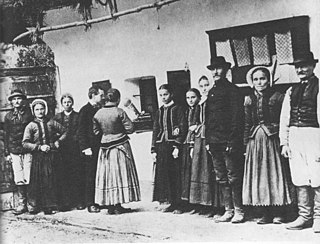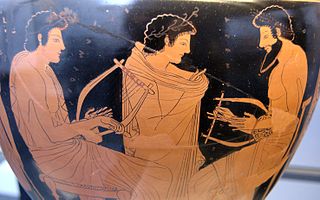
Folk music includes traditional folk music and the genre that evolved from it during the 20th-century folk revival. Some types of folk music may be called world music. Traditional folk music has been defined in several ways: as music transmitted orally, music with unknown composers, or music performed by custom over a long period of time. It has been contrasted with commercial and classical styles. The term originated in the 19th century, but folk music extends beyond that.

Music is an art form and cultural activity whose medium is sound organized in time. General definitions of music include common elements such as pitch, rhythm, dynamics, and the sonic qualities of timbre and texture. Different styles or types of music may emphasize, de-emphasize or omit some of these elements. Music is performed with a vast range of instruments and vocal techniques ranging from singing to rapping; there are solely instrumental pieces, solely vocal pieces and pieces that combine singing and instruments. The word derives from Greek μουσική . See glossary of musical terminology.

A song is a musical composition intended to be vocally performed by the human voice. This is often done at distinct and fixed pitches (melodies) using patterns of sound and silence. Songs contain various forms, such as those including the repetition and variation of sections.

Musical composition, music composition, or simply composition, can refer to an original piece or work of music, either vocal or instrumental, the structure of a musical piece, or to the process of creating or writing a new piece of music. People who create new compositions are called composers. Composers of primarily songs are usually called songwriters; with songs, the person who writes lyrics for a song is the lyricist. In many cultures, including Western classical music, the act of composing typically includes the creation of music notation, such as a sheet music "score," which is then performed by the composer or by other instrumental musicians or singers. In popular music and traditional music, songwriting may involve the creation of a basic outline of the song, called the lead sheet, which sets out the melody, lyrics and chord progression. In classical music, orchestration is typically done by the composer, but in musical theatre and in pop music, songwriters may hire an arranger to do the orchestration. In some cases, a pop or traditional songwriter may not use written notation at all, and instead compose the song in their mind and then play, sing or record it from memory. In jazz and popular music, notable sound recordings by influential performers are given the weight that written or printed scores play in classical music.
The music of the United States reflects the country's pluri-ethnic population through a diverse array of styles. It is a mixture of music influenced by West African, Irish, Scottish and mainland European cultures among others. The country's most internationally renowned genres are jazz, blues, country, bluegrass, americana (music), rock, rhythm and blues, soul, ragtime, funk, hip hop, doo wop, pop, techno, house, folk music, disco, boogaloo, reggaeton, and salsa. American music is heard around the world. Since the beginning of the 20th century, some forms of American popular music have gained a near-global audience.

A composer is a musician who is an author of music in any form, including vocal music, instrumental music, electronic music, and music which combines multiple forms. A composer may create music in any music genre, including, for example, classical music, musical theatre, blues, folk music, jazz, and popular music. Composers often express their works in a written musical score using musical notation.

Throughout its history, the United Kingdom has been a major producer and source of musical creation, drawing its artistic basis from the history of the United Kingdom, from church music, Western culture and the ancient and traditional folk music and instrumentation of England, Scotland, Northern Ireland and Wales.
no composers, singers, producers and performers of the world. Germany is the largest music market in Europe, and third largest in the world.

The music of Greece is as diverse and celebrated as its history. Greek music separates into two parts: Greek traditional music and Byzantine music, with more eastern sounds. These compositions have existed for millennia: they originated in the Byzantine period and Greek antiquity; there is a continuous development which appears in the language, the rhythm, the structure and the melody. Music is a significant aspect of Hellenic culture, both within Greece and in the diaspora.

The music of Indonesia demonstrates its cultural diversity, the local musical creativity, as well as subsequent foreign musical influences that shaped contemporary music scenes of Indonesia. Nearly thousands of Indonesian islands having its own cultural and artistic history and character. This results in hundreds of different forms of music, which often accompanies by dance and theatre.
The term American folk music encompasses numerous music genres, variously known as traditional music, traditional folk music, contemporary folk music, or roots music. Many traditional songs have been sung within the same family or folk group for generations, and sometimes trace back to such origins as Great Britain, Europe, or Africa. Musician Mike Seeger once famously commented that the definition of American folk music is "...all the music that fits between the cracks."
The music of Armenia has its origins in the Armenian Highlands, where people traditionally sang popular folk songs. Armenia has a long musical tradition that was primarily collected and developed by Komitas, a prominent priest and musicologist, in the late nineteenth and early twentieth centuries. American ethnomusicologist, Jonathan McCollum is a notable scholar of Armenian music. Armenian music has been presented internationally by composers Aram Khachaturian, Alexander Arutiunian, Arno Babadjanian, Karen Kavaleryan as well as by pop musicians and performers such as duduk player Djivan Gasparyan, composer/instrumentalist Ara Gevorgyan, singers Sirusho, Eva Rivas and many others.

During the 20th century there was a huge increase in the variety of music that people had access to. Prior to the invention of mass market gramophone records and radio broadcasting, people mainly listened to music at live Classical music concerts or musical theatre shows, which were too expensive for many lower-income people; on early phonograph players ; or by individuals performing music or singing songs on an amateur basis at home, using sheet music, which required the ability to sing, play, and read music. These were skills that tended to be limited to middle-class and upper-class individuals. With the mass-market availability of gramophone records and radio broadcasts, listeners could purchase recordings of, or listen on radio to recordings or live broadcasts of a huge variety of songs and musical pieces from around the globe. This enabled a much wider range of the population to listen to performances of Classical music symphonies and operas that they would not be able to hear live, either due to not being able to afford live-concert tickets or because such music was not performed in their region.
Little is known about Hungarian music prior to the 11th century, when the first Kings of Hungary were Christianized and Gregorian chant was introduced. During this period a bishop from Venice wrote the first surviving remark about Hungarian folk song when he commented on the peculiar singing style of a maid. Church schools in Hungary taught Western Christian chanting, especially in places like Esztergom, Nyitra, Nagyvárad, Pannonhalma, Veszprém, Vác and Csanád; and later schools began focusing on singing, spreading Latin hymns across the country.

A march, as a musical genre, is a piece of music with a strong regular rhythm which in origin was expressly written for marching to and most frequently performed by a military band. In mood, marches range from the moving death march in Wagner's Götterdämmerung to the brisk military marches of John Philip Sousa and the martial hymns of the late 19th century. Examples of the varied use of the march can be found in Beethoven's Eroica Symphony, in the Marches Militaires of Franz Schubert, in the Marche funèbre in Chopin's Sonata in B flat minor, and in the Dead March in Handel's Saul.

Classical music is art music produced or rooted in the traditions of Western culture, including both liturgical (religious) and secular music. While a more precise term is also used to refer to the period from 1750 to 1820, this article is about the broad span of time from before the 6th century AD to the present day, which includes the Classical period and various other periods. The central norms of this tradition became codified between 1550 and 1900, which is known as the common-practice period.

Since Biblical times, music has held an important role in many Jews' lives. Jewish music has been influenced by surrounding Gentile traditions and Jewish sources preserved over time. Jewish musical contributions on the other hand tend to reflect the cultures of the countries in which Jews live, the most notable examples being classical and popular music in the United States and Europe. However, other music is unique to particular Jewish communities, such as klezmer of Eastern Europe.
A music genre is a conventional category that identifies some pieces of music as belonging to a shared tradition or set of conventions. It is to be distinguished from musical form and musical style, although in practice these terms are sometimes used interchangeably.
The Second New England School or New England Classicists is a name given by music historians to a group of classical-music composers who lived during the late-19th and early-20th centuries in New England. More specifically, they were based in and around Boston, Massachusetts, then an emerging musical center. The Second New England School is viewed by musicologists as pivotal in the development of an American classical idiom that stands apart from its European ancestors.
The accordion is in a wide variety of musical genres, mainly in traditional and popular music. In some regions, such as Europe and North-America it has become mainly restricted to traditional, folk and ethnic music. In other regions such as Mexico, the instrument is very popular in genres like Norteño, and in Brazil, it is a fixture in popular music styles as Sertanejo and Forró. In art music it is used in jazz music, an important exponent having been the North American accordionist Frank Marocco and in transcriptions from the operatic and light-classical music repertoire.











